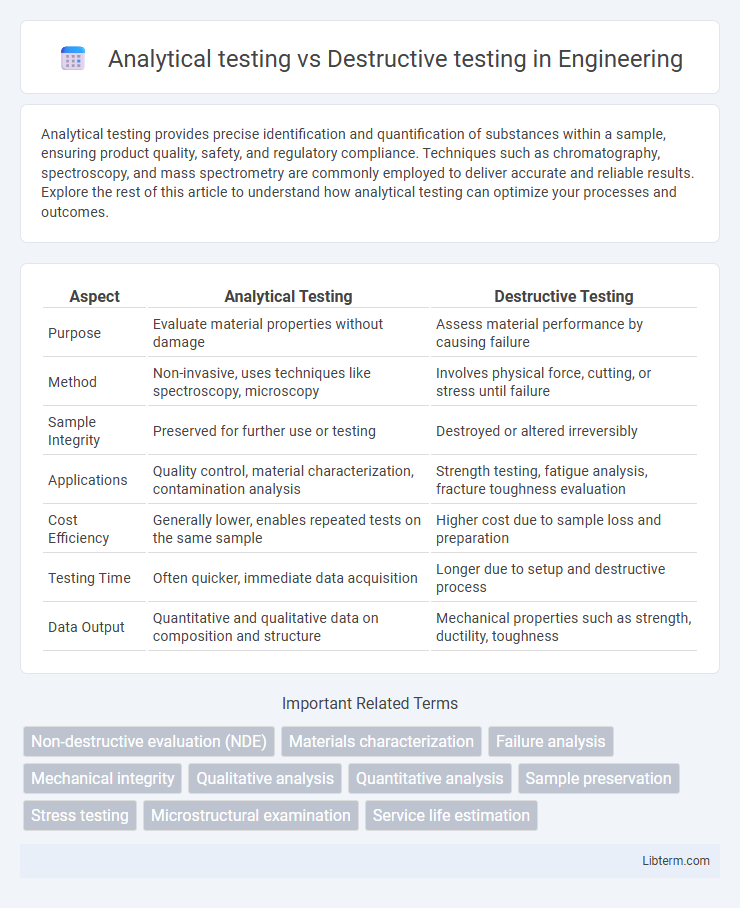Analytical testing provides precise identification and quantification of substances within a sample, ensuring product quality, safety, and regulatory compliance. Techniques such as chromatography, spectroscopy, and mass spectrometry are commonly employed to deliver accurate and reliable results. Explore the rest of this article to understand how analytical testing can optimize your processes and outcomes.
Table of Comparison
| Aspect | Analytical Testing | Destructive Testing |
|---|---|---|
| Purpose | Evaluate material properties without damage | Assess material performance by causing failure |
| Method | Non-invasive, uses techniques like spectroscopy, microscopy | Involves physical force, cutting, or stress until failure |
| Sample Integrity | Preserved for further use or testing | Destroyed or altered irreversibly |
| Applications | Quality control, material characterization, contamination analysis | Strength testing, fatigue analysis, fracture toughness evaluation |
| Cost Efficiency | Generally lower, enables repeated tests on the same sample | Higher cost due to sample loss and preparation |
| Testing Time | Often quicker, immediate data acquisition | Longer due to setup and destructive process |
| Data Output | Quantitative and qualitative data on composition and structure | Mechanical properties such as strength, ductility, toughness |
Introduction to Analytical and Destructive Testing
Analytical testing involves examining materials or components to determine their chemical composition, structure, or properties without causing damage, enabling precise quality control and research applications. Destructive testing evaluates a specimen's mechanical performance and durability by physically altering or destroying it to understand failure modes and safety limits. Both methods are essential in material science and engineering for comprehensive assessment and validation of product integrity.
Defining Analytical Testing: Principles and Methods
Analytical testing involves systematic examination and measurement of material properties using principles such as spectroscopy, chromatography, and microscopy to identify composition and structure without altering the sample's integrity. Techniques like Fourier-transform infrared spectroscopy (FTIR), gas chromatography-mass spectrometry (GC-MS), and X-ray diffraction (XRD) enable detailed qualitative and quantitative analysis for forensic or quality control applications. These methods emphasize preserving the sample while providing precise molecular or elemental information critical for product development, compliance, and research.
Understanding Destructive Testing: Key Concepts
Destructive testing involves evaluating materials or products by subjecting them to physical forces or stresses until failure occurs, providing detailed insights into their mechanical properties, strength, and durability. Key concepts include fracture toughness, tensile strength, impact resistance, and fatigue life, which are critical for ensuring safety and performance standards in industries like aerospace, automotive, and construction. This method contrasts with analytical testing, which is non-invasive and focuses on chemical composition and structural analysis without damaging the sample.
Core Differences Between Analytical and Destructive Testing
Analytical testing evaluates the composition and properties of a material or substance without altering its physical state, preserving the sample for further analysis or use. Destructive testing involves subjecting the material to stress or damage until failure occurs, providing insights into its mechanical strength, durability, and failure modes. The core difference lies in the non-invasive nature of analytical testing versus the irreversible impact caused by destructive testing methods like tensile, impact, or fatigue tests.
Applications of Analytical Testing in Industry
Analytical testing in industry is crucial for quality control, material characterization, and ensuring compliance with regulatory standards across sectors such as pharmaceuticals, food safety, and petrochemicals. Techniques like spectroscopy, chromatography, and thermal analysis enable precise identification of chemical composition and structural properties without harming the sample. This non-destructive approach supports research and development, process optimization, and failure analysis, enhancing product reliability and safety while reducing waste and production costs.
Common Uses of Destructive Testing
Destructive testing is commonly used in industries such as aerospace, automotive, and manufacturing to evaluate material strength, durability, and failure points by intentionally damaging or breaking samples. This method provides critical data for quality assurance, safety compliance, and performance validation of components under extreme conditions. Analytical testing, in contrast, often involves non-destructive techniques focusing on chemical composition and material properties without causing damage to the test sample.
Advantages of Analytical Testing
Analytical testing offers precise measurement of material properties without damaging the sample, allowing for repeated analysis and quality control in industries such as pharmaceuticals and manufacturing. It provides detailed chemical composition data, enabling early detection of defects and informing formulation adjustments. This non-destructive approach significantly reduces costs associated with sample loss and supports regulatory compliance through accurate, reliable results.
Benefits and Limitations of Destructive Testing
Destructive testing provides precise information about material properties by subjecting samples to stress until failure, ensuring accuracy in safety-critical applications like aerospace and construction. The main benefits include definitive data on strength, durability, and performance under extreme conditions, which cannot be obtained through non-destructive methods. Limitations involve the inability to reuse tested samples, higher costs due to specimen destruction, and time-consuming preparation and testing processes.
Choosing the Right Testing Method: Factors to Consider
Selecting the appropriate testing method depends on factors such as material type, required data accuracy, budget constraints, and project timeline. Analytical testing offers detailed compositional insights without damaging the sample, ideal for quality control and research applications. Destructive testing provides comprehensive mechanical properties by subjecting materials to stress until failure, essential when evaluating safety and durability despite sacrificing the tested sample.
Future Trends in Material Testing Technologies
Future trends in material testing technologies emphasize the integration of advanced analytical testing methods with destructive testing to enhance accuracy and efficiency. Emerging techniques such as AI-powered data analysis, non-invasive imaging, and real-time monitoring sensors enable predictive assessments, reducing the reliance on traditional destructive methods. Innovations in nanotechnology and machine learning algorithms are driving the development of hybrid testing systems that offer comprehensive insights while minimizing material consumption and test time.
Analytical testing Infographic

 libterm.com
libterm.com